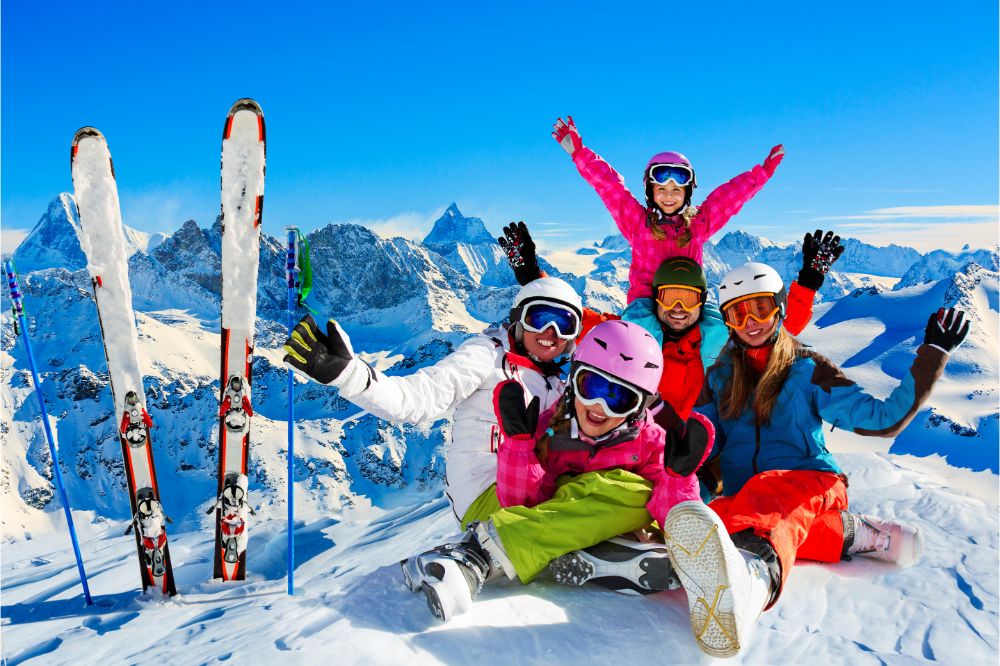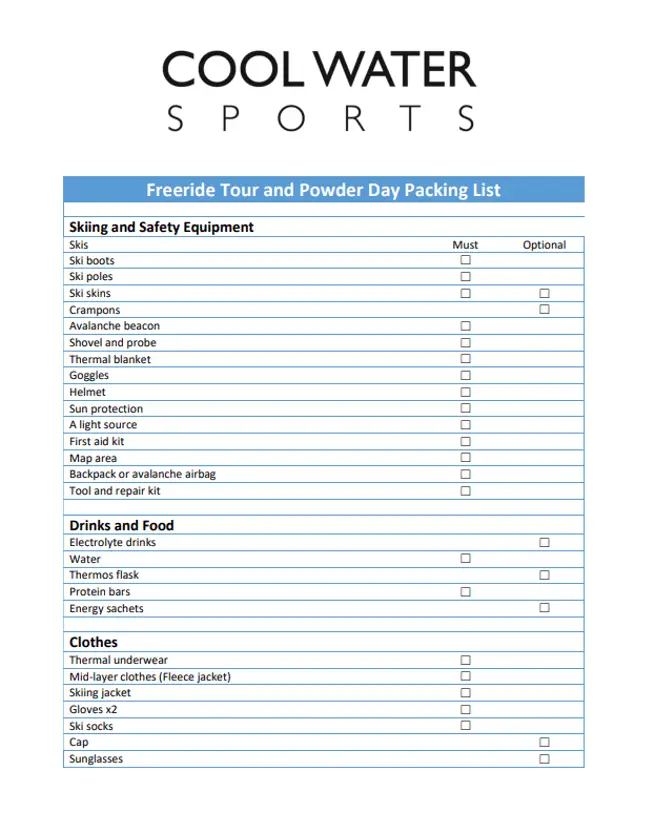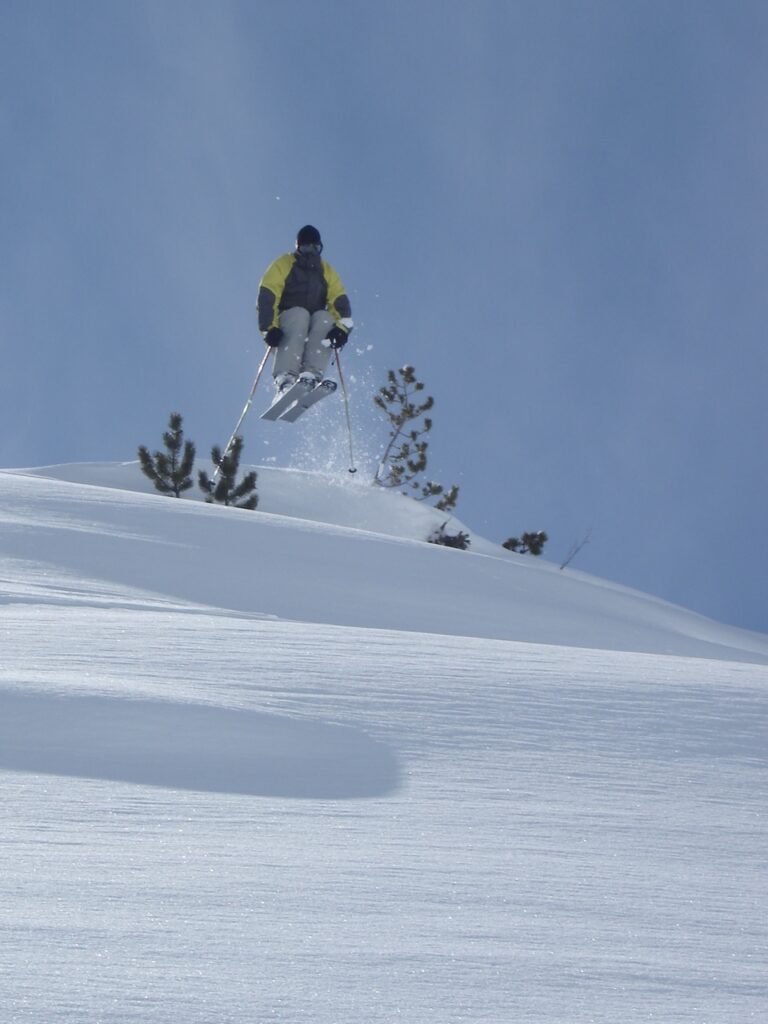The excitement of freeriding is something you can’t explain to anyone that hasn’t done it before; it needs to be experienced. The purpose of this article is to show you what this thrilling and versatile sport is all about.

We will look at what freeride skiing really is and what basic know how you need to have before starting out in the powder. Powder skiing is simply the ultimate adrenaline rush, but it is advisable to follow a few basic tips and safety rules so that you can really enjoy it.
Read on to learn what Freeride Skiing really is and everything you need to get involved.
What Is Freeride Skiing or Powder Skiing?
Freeride, or also called Powder skiing is a type of skiing executed on an un-groomed snowy hill or mountainside, similar to normal skiing. In this case, the terrain is left in its natural state and is compared to today’s perfectly prepared slopes, quite rough, and therefore needs more skill to ride and more knowledge about the mountains and snow in general.
In short: Freeride skiing is any type of skiing in which a skier leaves marked slopes, opting for the natural environment of unmarked mountains.
This special adventure is a unique experience that allows you to leave your trail and make your mark on the mountainside. Every action you take will have an impact on the surrounding environment and the outcome of your skiing, so it is quite exhilarating.
When Powder Skiing, you need fast reactions and quick thinking on your feet while going downward. You need to have strong nerves to take this challenge and go down that hill or mountainside with only your skis and thoughts.
But if done right, Skiing through powder snow is an explosive experience you will not normally have on normal ski trails. While freeride skiing, you are mostly on your own and must rely on your athletic prowess and intuition to carve the right path. However, the feeling after a great and successful powder ride is incomparable!
Still, you need to know some crucial aspects in order to really enjoy freeride skiing. This is what we’re going to explain next.
Snow Conditions
Snow conditions in ungroomed areas can have quite an impact on your freeride skiing experience with different conditions you may encounter. Slush, powder snow, wind-pressed snow, and firn can challenge every rider in a different way, while conditions can change without warning.
Steep Runs
Not all inclines are the same when it comes to skiing, and that is especially the case with freeride skiing. While steep runs of around 20 – 30 degrees are easier to ride than flatter plains, the terrain may change regularly as you go downhill.
But remember: steeper runs are more dangerous to ride because of the possibility of avalanches while going down. This means that new riders should try to avoid the steeper runs until they have a lot more experience and have improved their skill.
Lots of Obstacles In Your Way
We already mentioned that you will encounter different snow conditions, but that is not all there is on your way down when you are freeriding. Remember, this is an untampered area where nature throws a lot of obstacles your way in the form of trees, hills, and even rocks.
This is where some experience and a little more than just entry-level skills are required to navigate this path of nature.
Weather
Overall weather conditions at any given moment can also have an impact on your freeriding and may test your skill level. The fact that there are no signs and indications of where you should go can make it difficult in snowy and especially foggy conditions.
While we know that visibility can change at any moment on the freeriding trials, an open sky can make a huge difference.
What to Consider When Doing Freeride Skiing
You need to consider several things before you decide to go out there on your skis for freeriding. Here is a list of some pointers to think about so you can be safe when you are flying down the mountainside follows.
Skill Level
This type of adrenaline sport is not for everyone; you should feel comfortable on skis and be able to ski every marked slope without trouble. This means that you need at least any level above green to take on the un-groomed path of nature.
Special instructors provide training for freeride skiing, and they go with you on your first few trips.
Some Experience
To be an accomplished skier is not enough if you want to enjoy freeride skiing; you also need some experience on the mountain. That is why it is so important to make use of a professional instructor while you are learning this type of sport.
An instructor will teach you all you need to know about freeride skiing and also about wilderness safety and how to protect yourself.
Be Prepared
You can’t just go down the mountain with your skis on a freeriding activity without being properly prepared. Proper preparation means you must know how to behave while going down the mountain and potentially encountering numerous obstacles in nature.
You need to do proper route planning before you take on the mountain so you can know in advance what to expect. Before going down, you should also know the actual avalanche situation and take that into account for your planning.

The Right Equipment
It is also important to have the right equipment for freeride skiing and safety equipment in case of an emergency. You should have a list of things ready to take with you on every trip and every time you go down the mountainside.

- Freeride or All-mountain skis are first on your list of must equipment; these are specially designed to use in this type of skiing.
- Ski poles are a must for Powder Skiing. Make sure that the poles are the right length: if you place them on the ground with the handle and hold them with your full hand at the tip, above the plates, your elbow should make at least a right angle.
- Different types of avalanche equipment include a detector, a probe, and a strong and durable shovel that can withstand hard work.
- A proper outfit includes goggles, a helmet, and snow clothing to keep you warm and protected against cold and damage. Strong and durable gloves are also very important and provide extra protection in the case of an emergency to keep you warm.
- A backpack with some food and beverages, maybe an energy drink, and a thermal blanket can take you a long way. You will also need an up-to-date map and a mobile phone, so you can call in for help if there is a signal.
A more detailed description of the most important equipment for freeridering can be found here.
Some Extra Guidelines
These hints are very important, especially for beginners and entry-level freeride skiers who want to experience the excitement of this fast-paced sport. First of all, you should never go down a mountain on a freeride ski trail without someone to accompany you.
Even if you are an experienced skier on the traditional slopes, you should always have (at least!) a buddy with you on this ride. Beginners should, ideally, hire a guide who knows the area to take with them when they go down the mountain on a freeriding expedition.
Certain parks will require you to use their guides if you want to go down an off-piste trail when skiing. That is because they know the routes by heart and the avalanche situations that may occur in the area.
Beginners and those with little experience should, if possible, choose a route that is marked and controlled as a freeride slope. This doesn’t mean the slopes are prepared with machines, but rather freeride-specific slopes that come with all the warnings in place.
These marked freeride slopes are safe when it comes to avalanche situations, and you can fully focus on riding, learning, and improving. And those runs often provide similar adrenaline levels for you, so they are the ideal place to get started with freeriding.
Tips to Become a Good Freeride Skier
There are three basic rules besides the standard training you need to look at to become a better freeride skier.
The Right Skis
Having the right type of skis at your disposal is very important, especially in this fast and accident-prone environment. With freeride skis being much wider they generate much more uplift in soft and deep snow, which makes turning and controlling the skis easier.
Another option is to go with all-mountain skis. Compared to pure-breed powder skis they are less wide, stiffer, and have less rocker, which costs them performance in really deep snow but makes them better to ride on a harder surface. So if you plan only to go outside the slopes from time to time and want to have the most versatile skis possible, all-mountain skis are definitely the best choice.
The Right Boots
This may seem insignificant, but a good pair of ski boots will make a huge difference when freeride skiing. The right boot will give you proper feedback while skiing and provide a great rebound and good suspension.
They should also be very reliable and durable to last for many years of exciting freeride skiing without fail. Generally, Freeride ski boots are less rigid with more flexibility combined with normal ski boots, allowing the skier to compensate for changes in terrain and sudden movements.
Get the Basics Right
This is good advice for any type of sport or activity you may take part in; learn the basics and practice regularly. When you think you are good enough and know every move by heart, practice some more and remember it is only you out there.
Dare – and jump

Only practice makes perfect, so dare to try something new. Jumping in deep snow is not easy at the beginning, but increases the fun again in unimagined spheres.
Start small, but use small snow cornices, snow hills or smaller rocks and jump over them.
Make sure that you always stay centrally above the ski and have checked beforehand that the landing is free of hidden stones, tree trunks or other obstacles. Jumping is not only fun, it also trains extreme technique and safety on the ski and trains your eye to see other obstacles and “read” the snow surface.
And my god, is it fun!
We Are Fans of Watersports – Why Care About Freeride Skiing?
This is a good question, and you should remember that snow is also a form of water, just much colder. You can ride the snow hills and waves on your skis just as much as you ride the water waves for fun.
Because we love all the cool sports practiced on the water, we are also addicts of that cool ice wave riding down the mountainside. So believe us: if you love any of the cool water sports, you will love freeride skiing – and vice versa!
Conclusion
You need to know these facts about freeride skiing and everything that goes with it. It is just as much fun riding the snow as riding the waves on the water. With a little bit of persistence, a good instructor, and some basic know-how, anyone can learn to become a good freeride skier.
